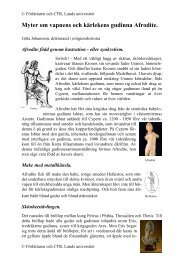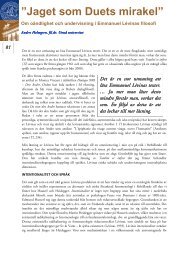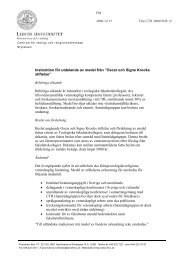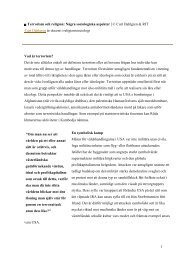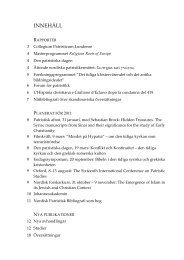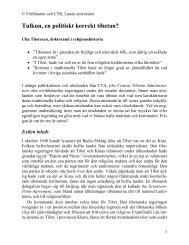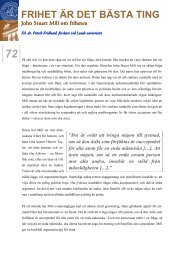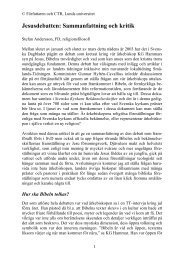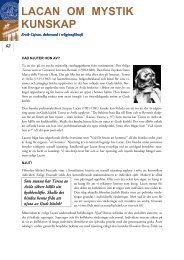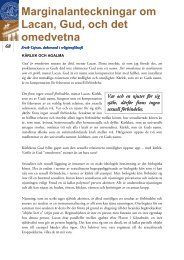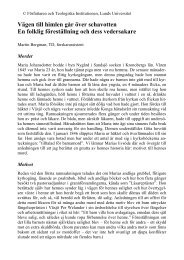Meddelanden 24 (2009) (PDF 780 kB - Nytt fönster) - Centrum för ...
Meddelanden 24 (2009) (PDF 780 kB - Nytt fönster) - Centrum för ...
Meddelanden 24 (2009) (PDF 780 kB - Nytt fönster) - Centrum för ...
You also want an ePaper? Increase the reach of your titles
YUMPU automatically turns print PDFs into web optimized ePapers that Google loves.
Anders Runesson discusses the origins of separate Christian and Jewish<br />
identities in his important essay “Inventing Christian Identity: Paul, Ignatius<br />
and Theodosius I.” Runesson first tackles the thorny problem of using such<br />
labels as “Christian” and Jew” in the ancient context. In one of the best discussions<br />
of this much debated topic Runesson argues that the Greek term<br />
Ioudaioi can be translated in many cases with the English words “Jew” or<br />
“Jewish.” The case is different, however, with the use of the term “Christian”<br />
which is anachronistic in a first-century context. Runesson suggests<br />
that the term “Apostolic Judaism” could be used for the religious identity of<br />
the first century Jesus believers in a similar way as we speak of Pharisaic or<br />
Essene Judaism. Those non-Jews who attached themselves to Apostolic<br />
Judaism could be called “Christ-fearers” while such second-century writers<br />
as Ignatius, who rejected any overlap between the identity of the Ioudaioi<br />
and their own identity, could be called “proto-Christians.” Runesson concludes<br />
that Paul’s Apostolic Jewish approach to non-Jews was a necessary<br />
factor in the development that led Ignatius to de-ethnosize belief in Christ<br />
which, in turn, had direct implications for later Christian empire building.<br />
Rikard Roitto’s essay “Behaving like a Christ-Believer: A Cognitive Perspective<br />
on Identity and Behavior Norms in Early Christ-Movement” argues<br />
that a cognitive approach provides a coherent framework to understand the<br />
connection between identity in Christ and the narrative meanings and social<br />
dynamics of behavior norms. Roitto presents in an accessible way how<br />
cognitive research has been applied to the study of religion and culture.<br />
Roitto follows cognitive scholars in claiming that the concept of culture is<br />
ontologically unintelligible, a conclusion that poses a challenge to Gerd<br />
Theissen’s definition of early Christianity as an independent cultural sign<br />
system. Roitto also brings into discussion the social identity approach<br />
developed by Henri Tajfel and others and shows how this approach can<br />
illuminate the use of ingroup prototypes to promote early Christian social<br />
identity.<br />
The social identity approach and prototypes have an important role also<br />
in Mikael Tellbe’s essay “The Prototypical Christ-Believer: Early Christian<br />
Identity Formation in Ephesus.” He discusses the Pastorals, the Johannine<br />
Epistles and Revelation that all have been connected to Ephesus and that<br />
display remarkable differences with regard to such themes as legitimacy and<br />
leadership structures, societal relations, community metaphors and the<br />
prototypes of Christ-Believers. Tellbe speculates about the possibility that,<br />
for example, the Johannine Epistles were written in critical response to such<br />
ideas concerning authority and legitimacy that are expressed in the<br />
Pastorals. Tellbe finds points of commonality between all these writings in<br />
the significant role of itinerant leaders and in a common pattern of the story<br />
of Jesus and the ethical response to this story. It can be questioned, however,<br />
- 74 -



